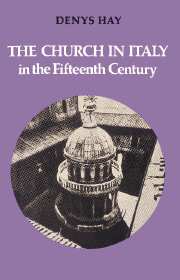Book contents
- Frontmatter
- Contents
- PREFACE
- 1 The problems of Italian church history
- 2 Diocesan and parochial organisation
- 3 The Schism in Italy: the emergence of an Italian papacy
- 4 The state of the clergy and laity in fifteenth-century Italy
- 5 The quality of Italian religious life. Reform
- 6 The Italian Renaissance and the clergy of Italy in the fifteenth century
- APPENDIX
- NOTES
- REFERENCES
- INDEX (NOT INCLUDING APPENDICES)
4 - The state of the clergy and laity in fifteenth-century Italy
Published online by Cambridge University Press: 22 October 2009
- Frontmatter
- Contents
- PREFACE
- 1 The problems of Italian church history
- 2 Diocesan and parochial organisation
- 3 The Schism in Italy: the emergence of an Italian papacy
- 4 The state of the clergy and laity in fifteenth-century Italy
- 5 The quality of Italian religious life. Reform
- 6 The Italian Renaissance and the clergy of Italy in the fifteenth century
- APPENDIX
- NOTES
- REFERENCES
- INDEX (NOT INCLUDING APPENDICES)
Summary
Secular clergy
In this chapter some impressions will be given of the clergy of Italy, seculars and regulars, and of the laity to whom many of them ministered. In approaching in this way somewhat nearer to the actual religious life of the period it is important not to forget how varied were the organisations in which Christians found themselves, even in the one obedience, even in one country or region, before the sixteenth century. I remarked before how difficult a problem it was to get behind Trent, when a mask of uniformity was laid on Roman Catholic Europe. We must constantly remind ourselves that the concepts of the parish, of the bishop and perhaps even of the cloister, were much more fluid in the Middle Ages, at any rate after the twelfth century, than in the epoch of the Counter-Reformation, or the Catholic Reformation as one is nowadays encouraged to call it. Despite papal leadership, despite canon law, a thousand years of Latin Christendom had left many oddities and variations; it is far from being the case that the services of the church were the same all over the Latin west; and the organisations that supported these services varied to an even greater degree. The discussion of the diocese and the parish in chapter 2 will have made this pretty evident to anyone at all familiar with the medieval churches of England or France.
This deserves to be stressed at the outset, since in England and in other northern European countries we are accustomed to find out about the pre-Reformation situations – both of laity and clergy – through the records maintained by bishops and their chanceries.
- Type
- Chapter
- Information
- The Church in Italy in the Fifteenth CenturyThe Birkbeck Lectures 1971, pp. 49 - 71Publisher: Cambridge University PressPrint publication year: 1977



